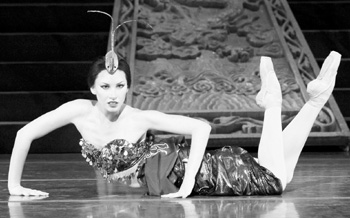![[Metroactive Arts]](/arts/gifs/art468.gif)
[ Arts Index | Silicon Valley | Metroactive Home | Archives ]

Slither and Yon: Alexsandra Meijer turned contortionist for the Year of the Snake. Culture Salute The ballet's 'Middle Kingdom—Ancient China' paid tribute in dance to China's history By Marianne Messina IN CELEBRATING the grand achievements of Chinese civilization, Middle Kingdom—Ancient China, a co-production of Ballet San Jose Silicon Valley and Chinese Performing Artists of America, is itself a grand achievement. Generally following the legend-based history set down by Confucian historians to link China's technological landmarks through a consistent genealogy, Middle Kingdom—Ancient China sweeps over thousands of years of history, from the merging of tribes under a centralized government to world-altering inventions like gunpowder and paper. When the Han Emperor Heh (CPAA's Xing Jiu Liu) in his elaborate ceremonial robes mounts the same imperial throne the Yellow Emperor occupied nearly a thousand years before, the sense of cultural accretion and continuity is daunting. One can't help but reflect that the entire history of the United States could fit within the span of a short Chinese dynasty. And China's ability to synthesize diverse and enduring philosophical innovation is always running in the subtext. Designed by Ching Shyu and constructed in Beijing, the costuming combines concept, information and spectacle. Each individual costume is a showpiece of coordination—peacocks have blue and gold eyes on white leotards, feather plumes painted on white tights, blue, pink and gold on translucent wings. On the broader canvas, the costume design often works suggestively. In the battle between the two peoples, Yan and Huang (traditionally presented as the more cultured), the Huang costumes are lean, skin-fitting and metallic; the "barbarian" costumes are thick, furry and dark, shin-tight bronze boots vs. bulky, furred brown boots. The costumes also carry symbolic information. Offering incantations before his huge red furnace, the white-haired imperial Taoist priest (Xing Jiu Liu) who inadvertently invents gunpowder (in search of youth potions) wears both the Taoist yin-yang and a suggested Yijing (I Ching) hexagram on his gold robes. Unfortunately, the musical score (composed expressly for the production by CPAA's Phil Young) treated Asian instrumentation as subtle flavoring in a predominantly Western orchestration. This tack means that the audience misses out on music's ability to translate and inculcate culture, and it downplays the symbiosis between culture, geography and sound. This lost opportunity is perhaps most egregious in the music for the "Peacock Dance" (Willie Anderson, Maximo Califano, Damir Emric, Daniel Gwatkin), a Chinese/Thai tradition set to music confoundingly eager to celebrate Tchaikovsky right down to the incidental percussion. At a recent matinee, the joint efforts of these two accomplished dance companies treated the audience—representing an amazing melting pot of ages and ethnicities—to countless memorable moments. The red-lit sky of a sunset gave a quiet kind of pause; the entrapment and tumbling disappearance of the Yan commander (Yingchou Zhang) pulled off a well-loved startle. Swimming through darkness, the glowing dragon—iridescent indigo, pink, green, orange—had the ponderous hypnotic beauty of an electric eel at the ocean's black depths (manned by seven black-clad dancers from the CPAA company). The animals of the Zodiac enthralled with their creative movement—Fei Chen's itchy, skittish monkey; Willie Anderson's thundering horse; Maria Jacobs' delicate, lovable rat; Stephane Dalle's sleek and regal golden dragon; Alexsandra Meijer's glittering, slithering snake. Messengers carrying the emperor's "literally tons" of pre-paper bamboo documents on a pole brought comic relief as they argued over who'd get the heavy end of the stick. Alex Lapshin and Alexandra Koltun (as the Yellow Emperor and his bride Leizu) brought splendor in the powerful overhead lifts of their traditional pas de deux, which ended in one of choreographer Dennis Nahat's lovely tableaux—Koltun lifted by Lapshin to form a bird flying against a red back light. The grand finale is called "The People." But it's such a convocation of shapes, colors, textures, movement, of ideologies, of eras built upon eras, that it's hard not to think of "The People" in a sense much broader than the People's Republic of China, one that invites us all to take part in China's accomplishment as a flower of human ingenuity.
Send a letter to the editor about this story to letters@metronews.com. [ Silicon Valley | Metroactive Home | Archives ]
|
From the February 16-22, 2005 issue of Metro, Silicon Valley's Weekly Newspaper.
Copyright © Metro Publishing Inc. Metroactive is affiliated with the Boulevards Network.
For more information about the San Jose/Silicon Valley area, visit sanjose.com.